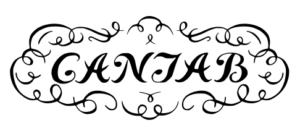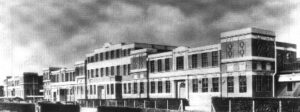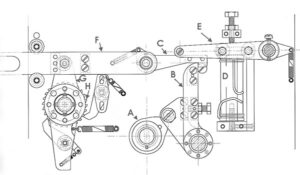BTM – BRITISH TABULATING MACHINE COMPANY LTD.
BTM owed its origins to Herman Hollerith who invented punched-card machines in the States in the 1880s. In 1896 Hollerith formed a small business in the United States to manufacture and market his machines. In 1908, this little-known American firm, the Tabulating Machine Company (TMC), gave an exclusive license to the British Tabulating Machine Company of London to market its punched-card machines in Britain and the Empire. The American Company subsequently became IBM and the British firm became ICT and later ICL.
By 1940, BTM’s biggest pre-war development project was the Rolling Total Tabulator and being of British design gave BTM a high level of technical independence from IBM. The oppressive agreement with IBM was dissolved in 1949.
The Rolling Total Tabulator contained many ingenious British mechanisms and many of these in adapted form can be recognised in the Bombe design.
However the incredible speed at which the first Bombe was developed did not allow for unnecessary design and development so where possible mechanisms from other punched-card equipment were used with minimal modification.
BRITISH TABULATING MACHINE COMPANY – MAIN FACTORY
ICKNIELD WAY, LETCHWORTH
Much as it would have appeared in the early 1940s.
Bombes were loaded onto an Army lorry from the set back loading bay situated at the left hand end near to where the cars are parked.
WARTIME PRODUCTION
Approximately 210 Bombes of all different types were produced at Letchworth from 1940 to 1945. Letchworth incidentally is 33 miles from Bletchley Park and 36 miles North of Central London. Final assembly took place in the main BTM factory in Icknield Way. This factory later became known as 1/1 but has now sadly been demolished to make way for a housing estate.
Sub-assemblies for the Bombes, including the frames were produced at other Letchworth factories — wiring at Spirella and engineering of the drums and other parts in the basement of the Ascot, Government Training Centre in Pixmore Avenue.
Interestingly the Spirella building, first built to house the manufacture of ladies corsets was in the news again. HRH Prince Charles formally opened the building following its total restoration at the end of January 1999. This work was put in place by the Letchworth Garden City Heritage Foundation at a cost of £10M.
The first Bombes took six weeks to construct but, later, when built in batches of six, one came off the assembly line each week.
Security had to be as good at Letchworth as it was at Bletchley Park and although literally hundreds of people were involved in the Bombe production, the secret was kept. In fact the security was deliberately kept very low key. New Bombes were collected from the main factory loading ramp, visible from the main road, by a single soldier with an army lorry. He then set off to Bletchley Park or one of the Out-Stations without any form of escort! Nobody took any notice.
THE B.T.M. TEAM
Whilst the general concepts of the Bombe was provided by Bletchley Park. It fell to the B.T.M. design team at Letchworth in North Hertfordshire to design a practical machine.
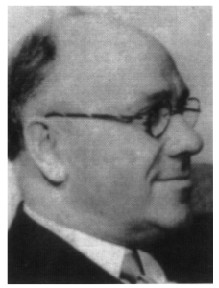
Commander Travis,
who took over from Alastair Denniston as head of Bletchley Park was a frequent visitor to Letchworth. He sent a letter of congratulation to (Doc) Keen dated 24th May 1945 and asked that all those who contributed to the manufacture of the Bombes should be congratulated.
We also know that many of those referred to would have received a diploma from BTM. The text of which is reproduced below.
The British Tabulating Machine Company Ltd
The Board of Directors of The British Tabulating Machine Company Limited wish to convey to you their sincere thanks for the valued assistance you have given in the fulfilment of the Cantab Contract.
It will be gratifying to you to know that His Majesty’s Lords Commissioners of the Admiralty have expressed their appreciation of the rapid and efficient production of the Cantab equipment which has materially assisted in the successful prosecution of the war.
Yours faithfully
R. Phillpotts, Esq.
The Chairman,
British Tabulating Machine Co. Ltd.
New Icknield Way
Letchworth, Herts.
POST WAR AWARDS
Although the Bombe project was to be kept secret for about forty years this did not stop the authorities from making certain awards. The most notable were
- Raleigh Phillpotts {Chairman} a Knighthood
- H.H. (Doc) Keen an OBE
- H.J. Morton (Keen’s principal assistant) an MBE.
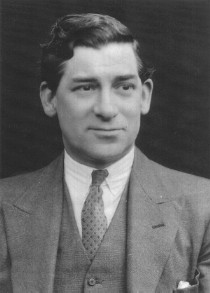
H.H. (Doc) Keen OBE
Photograph taken in 1946
(This photograph and various personal letters were kindly provided by John Keen)
CANTAB
The World War 2, BTM manufactured code breaking equipment is usually called a Bombe by those involved at Bletchley and the various outstations. However in Letchworth they were more commonly known as 6/6502 or CANTAB machines. By early 1945 the bombe programme was winding down rapidly. To mark this a celebration dinner was held in Letchworth and those who worked on the bombe were given diplomas. As part of this a Cantab logo was produced and appeared on these diplomas and on the menu card produced for the celebration dinner. We have therefore adopted this logo as part of the rebuild project.
BUREAU ‘B’
Of late we have heard many references to Bletchley Park being called Station X. It is interesting to note that at BTM’s London head office they always referred to Bletchley Park as Bureaux ‘B’.
Transcript of an interesting, original hand written letter
c/o Mrs. Farwell
208, Buckingham Road
Bletchley
Bucks.
June 16th 1945
Dear Mr Keen,
I was very pleased to see your name in the list of awards of the O.B.E. in the Birthday Honours, particularly since I know that the honour is more than well deserved. I should like to congratulate you most warmly.
I hope that this together with the satisfaction of a good job well done, will seem a fitting reward for the vast amount of thought and the fantastically long hours, which you have put in during the last five years. And I hope you are able now to relax a little of the tension.
Since VE Day Hut Six has seen a rapid exodus. Our five hundred members are now down to twenty and those, like myself, are writing the History for the official records – in rooms which are empty and silent. It is a great change from the whirl and bustle of two months ago.
I wonder how Letchworth has reacted to the end of the War. No doubt at BTM there is a tremendous amount of tidying-up to do, for the War has been a ‘messy’ game as you – of all people – know.
I have always been interested in the BTM side of our work, and have always enjoyed coming to Letchworth to inspect, to discuss, or to petition – the last option rather guiltily. Thank you for all the trouble you have taken on these occasions. I hope that I may have the pleasure of one day making more “official” visits to Tab. – when perhaps we shall not speak quite such different languages!
With all good wishes to you, and renewed congratulations.
Yours sincerely
Oliver H Lawn.
Interesting Note: Oliver Lawn wrote up many of the notes on internal BP discussions and meetings. These have survived. Oliver and his wife Sheila, who also worked at BP, have revisited our project at Bletchley Park. Sadly Oliver and Shiela have now passed away. They were both strong supporters of our Rebuild.
During the early 1940s electronics had not yet become the main vehicle for solving intricate Business and Office Data Processing problems. Electro-mechanical solutions were still the main method by which problems were resolved and the techniques were well developed. These methods and techniques plus some very inventive minds existed in BTM and were quickly applied to the business of Code Breaking. Speed of implementation was also a strong attribute, which had been developed in dealing promptly with punched card customers needs. The first Bombe was delivered to Bletchley Park in March 1940 in what was only a matter of months after the declaration of war.
One example of this ingenuity was the successful adaptation of a tabulator paper feed mechanism to the problem of progressing the middle and lower drums one position (of 26) for each rotation of the drum above.
Referring to the diagram which is a view from the front of the machine. Cam A, of which there are six, rotate continuously as they are geared to the 3 banks of twelve upper drums. The ‘carry’ to the middle three sets of twelve drums needs to take place after all 26 positions of the upper drums have been sensed. i.e. after one revolution.
As cam A rotates arm B will “nod” from left to right and back. Normally this is all that will happen because the top tip of arm B will just clear hook C.
When a carry is required a cam (not shown) on the Contact Breaker mechanism, also geared to the top drums, will make a contact which will energise solenoid D, pulling down arm E and thereby pushing down hook C.
When arm B next moves to the right, hook C will be engaged and the whole of the carry bar F will move to the right and then return.
This action will cause the “banana” G to rotate clockwise and return. The pawl on the banana pushing round the ratchet H. The result is that the ratchet is rotated one notch. i.e. 1/26th of a complete rotation. The fixed pawl will prevent the ratchet returning to its original position.
Each ratchet H is attached to a shaft, which passes through bearings to the front of the machine, and onto which the middle or lower drums, are mounted.
Each carry bar F drives 12 bananas and therefore 12 middle drums. There are three such middle carry bars on each machine and these cause the 36 middle drums to rotate one position for every revolution of the top drums.
The carry to the three sets of twelve slow drums is virtually identical to the middle mechanisms. The only difference is that the carry only operates for every 26th position of the middle drums. Another contact on the middle drum mechanism (also not shown) ensures that the lower drums only rotate 1/26th turn when the middle drums have made one full rotation.
A further contact (also not shown) attached to the slow drums ensures that the machine stops after 26 x 26 x 26 senses. This will only happen if the machine does not previously find a valid “stop”
Hollerith/ICT Supporters
The project is very fortunate in having had the support and encouragement of many retired senior BTM/ICT/ICL managers. In particular we had Arthur Humphries CBE – Managing Director and Deputy Chairman providing help and assistance until his sad death
